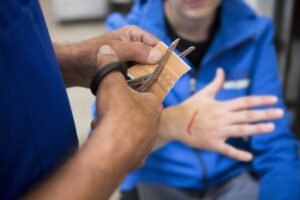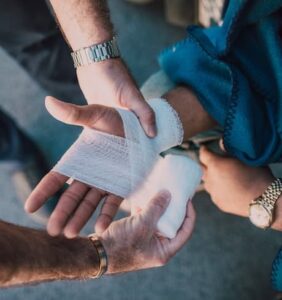Back to: Physical and Health Education JSS 2
Welcome to class!
In today’s class, we shall be talking about the applications of simple first aid treatment. Please enjoy the class!
Applications of Simple First Aid Treatments

Life on campus is full of late nights, early mornings, and a fair share of bumps and bruises. Whether it’s a paper cut from a last-minute study session or a sprained ankle from a campus frisbee game, knowing some simple first aid techniques can be your saving grace. Today, we’ll delve into the practical applications of these essential skills, equipping you to handle common injuries with confidence.
Bleeding Control:

The sight of blood can be alarming, but remember, most bleeding can be easily managed. Here’s your arsenal:
Direct pressure: This is the golden rule. Apply firm, steady pressure directly over the wound using a clean cloth or sterile gauze. Hold for at least 5 minutes, and repeat if necessary.
Elevation: Raise the injured area above the heart to slow blood flow. This is especially effective for extremities.
Pressure points: In cases of severe bleeding from limbs, locate pressure points where arteries pass close to bones. Firmly press on these points for a few minutes until bleeding subsides.
Wound Care:

Once the bleeding is under control, it’s time to prevent infection:
Cleanse the wound: Gently flush the area with clean water or sterile saline solution to remove dirt and debris.
Apply an antiseptic: Use a mild antiseptic like iodine or hydrogen peroxide to kill bacteria. Don’t overdo it!
Cover the wound: Use a sterile bandage or dressing to protect the wound from further contamination and promote healing. Change the dressing regularly to keep it clean and dry.
Pain Management:
Minor aches and pains are inevitable, but you don’t have to suffer:
Rest and immobilize: Give the injured area time to heal. For sprains and strains, consider using a splint or brace to keep the joint stable.
Ice: Apply an ice pack wrapped in a towel to the affected area for 15-20 minutes at a time, several times a day. This reduces swelling and pain.
Over-the-counter pain relievers: Consider taking medications like ibuprofen or acetaminophen to manage discomfort.
Pro-Tips:
Stock a first-aid kit: Keep essential supplies like bandages, antiseptic wipes, pain relievers, and ice packs readily available.
Stay informed: Take a first aid or CPR course to refine your skills and gain confidence in handling emergencies.
Seek professional help: Don’t hesitate to seek medical attention for serious injuries or persistent problems.
Conclusion:
Simple first aid skills are not just about bandages and ice packs, they’re about empowerment. By understanding and applying these techniques, you can transform from a helpless bystander to a confident caregiver, ready to face any campus adventure with a little more peace of mind. So, go out there, explore, learn, and remember, a little first aid knowledge can go a long way!
We have come to the end of today’s class. I hope you enjoyed the class!
In the next class, we shall be discussing Qualities of a good first aider.
In case you require further assistance or have any questions, feel free to ask in the comment section below, and trust us to respond as soon as possible. Cheers!
Question Time:
- Explain the scientific rationale behind the RICE method (Rest, Ice, Compression, Elevation) for treating sprains and strains.
- Compare and contrast the treatment approaches for different types of wounds (cuts, scrapes, punctures).
- You encounter someone with a minor burn. Would you use ice or heat? Why or why not? Discuss potential risks and benefits of each approach.
